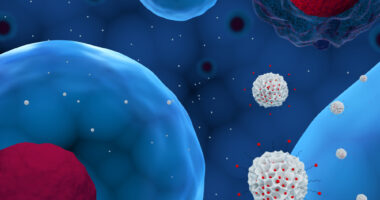Inflammatory Immune Cells May Be Biomarker for Juvenile Type of ALS

Amyotrophic lateral sclerosis (ALS) type 4 — a juvenile and slowly progressive form of the neurological disease, called ALS4 — is driven by abnormal mechanisms in both the central nervous system and the immune system, a new study reports.
In particular, patients with this condition have increased levels of inflammatory immune cells called CD8 T-cells, which may serve as a potential biomarker for monitoring disease progression.
Researchers noted that the “CD8 T cell signature that we describe here for ALS4 is yet to be identified (to our knowledge) in any other [motor neuron disease],” and “could be used to unravel disease mechanisms” in ALS.
The study, “Clonally expanded CD8 T cells characterize amyotrophic lateral sclerosis-4,” was published in Nature.
ALS4 is a form of ALS caused by mutations in the SETX gene. The first symptoms usually appear sometime during childhood or in the early teen years, and slowly worsen over a person’s lifetime. While this type of the disease is not generally fatal, most patients require a wheelchair or walking aids around their 50s.
Many prominent ALS-related mutations — such as those in the SOD1 and C9ORF72 genes — cause a dysregulation of the immune system that is thought to contribute to disease progression. But whether SETX mutations also affect immune function is unknown.
Now, an international team of scientists conducted a series of experiments to determine the impact of mutations in the SETX gene on the immune system. First, comprehensive analyses were done of immune activity in mice with the most common ALS4-causing mutation in the SETX gene, called L389S.
Results broadly showed that immune activity was comparable between ALS4 and healthy mice; for example, levels of most inflammation-driving signaling molecules (cytokines) were similar.
But the researchers noted marked differences from previous findings with other ALS-causing genes. For instance, mutations in C9ORF72 have been shown to increase the production of a powerful inflammatory cytokine called interferon, but the SETX mutation did not impact interferon production in cells.
The numbers of immune cell subsets also were generally comparable between ALS4 and control mice, with one notable exception: activated CD8 T-cells expressing the marker programmed cell death protein 1, known as PD-1.
The team noted that this increase was found in the mice’s blood, and also in the central nervous system (CNS), comprising the brain and spinal cord. Notably, this T-cell signature was not seen in models of other ALS types.
T-cells are immune cells equipped with specialized receptors that recognize a single target molecule, called an antigen (for example, a piece of a virus). When the T-cell’s receptor binds to its antigen, the cell is activated, sending out signaling molecules to coordinate the immune response and also quickly dividing to make more, identical T-cells — a process called clonal expansion.
CD8 T-cells are a particular inflammatory subset of these cells that are capable of killing the body’s own cells. These cells normally help to eradicate cancer cells, as well as cells that have become infected with a virus.
The PD-1 protein is a marker of T-cell activation, and further profiling of these cells confirmed that they retained their inflammatory capacities. Results also showed evidence of clonal expansion: in individual mice, as many as 60% of the PD1-positive CD8 T-cells in the CNS were produced from the same initial cell.
“Our data strongly support the hypothesis of an antigen-driven mechanism of CD8 T cell activation,” the researchers wrote. “This phenomenon could be either a cause or an effect of the neurodegenerative process.”
In further experiments, the researchers injected the mice with one of two types of cancer cells: a brain cancer (glioma), or a skin cancer (melanoma). In ALS4 mice, the gliomas — which express many CNS proteins that could theoretically act as T-cell antigens — were markedly smaller than in wild-type mice. Meanwhile, no difference was noted for melanoma, whose cells don’t express CNS proteins.
“We conclude that [ALS4] mice express a population of activated CD8 T cells, the repertoire of which is skewed toward antigens of CNS origin,” the researchers wrote.
The scientists next generated mice that expressed the ALS4-causing L389S mutation, either only in their blood cells (including T-cells) or in all parts of the body except for blood cells. In both cases, the mice did not show any evidence of motor defects or nerve damage that is typical of this model of ALS.
These results imply that the expression of the mutation in blood cells is necessary for the development of ALS4, as well as “supporting the idea that dysfunction in both the CNS and the [blood] or immune system contributes to disease ontogeny [development] or progression,” the researchers wrote.
“We learned that mutations in SETX need to be expressed in both the nervous and immune systems to generate motor impairment in mice, and that dysfunction in the adaptive immune system characterizes ALS4 in mice as well as humans,” Laura Campisi, PhD, professor of microbiology at the Icahn School of Medicine at Mount Sinai, said in a press release.
Campisi is a co-lead author of the study together with Ivan Marazzi, PhD, also a professor of microbiology at Icahn Mount Sinai.
In a final set of experiments, the scientists characterized T-cells in blood samples from people with or without ALS4. While T-cell numbers were generally reduced in ALS4 patients, results indicated a higher proportion of activated CD8 T-cells, and there was evidence of clonal expansion — consistent with the results of mouse experiments.
“We have identified an immune signature that is characterized by activated antigen-specific CD8 T cells in ALS4,” the scientists concluded, adding that monitoring these cells “could be a potential biomarker to monitor the progression of disease in patients with ALS4.”
The team speculated that this T-cell signature might arise due to increased cell death and damage in the CNS, which promotes an inflammatory environment and increases the likelihood that a T-cell might mistake a healthy CNS protein for an infectious threat. However, the scientists stressed that more research is needed to investigate the potential mechanisms, and to define specific antigens that are being targeted.








